Postmodernist Perspectives in Healthcare: Implications for Practice
VerifiedAdded on 2022/11/16
|11
|6276
|151
AI Summary
This article discusses the postmodernist approach in healthcare and its implications for practice. It highlights the limitations of the approach and the need for a more holistic approach to treatment. The article also discusses the sociocultural complex known as the 'postmodern condition' and its impact on healthcare.
Contribute Materials
Your contribution can guide someone’s learning journey. Share your
documents today.
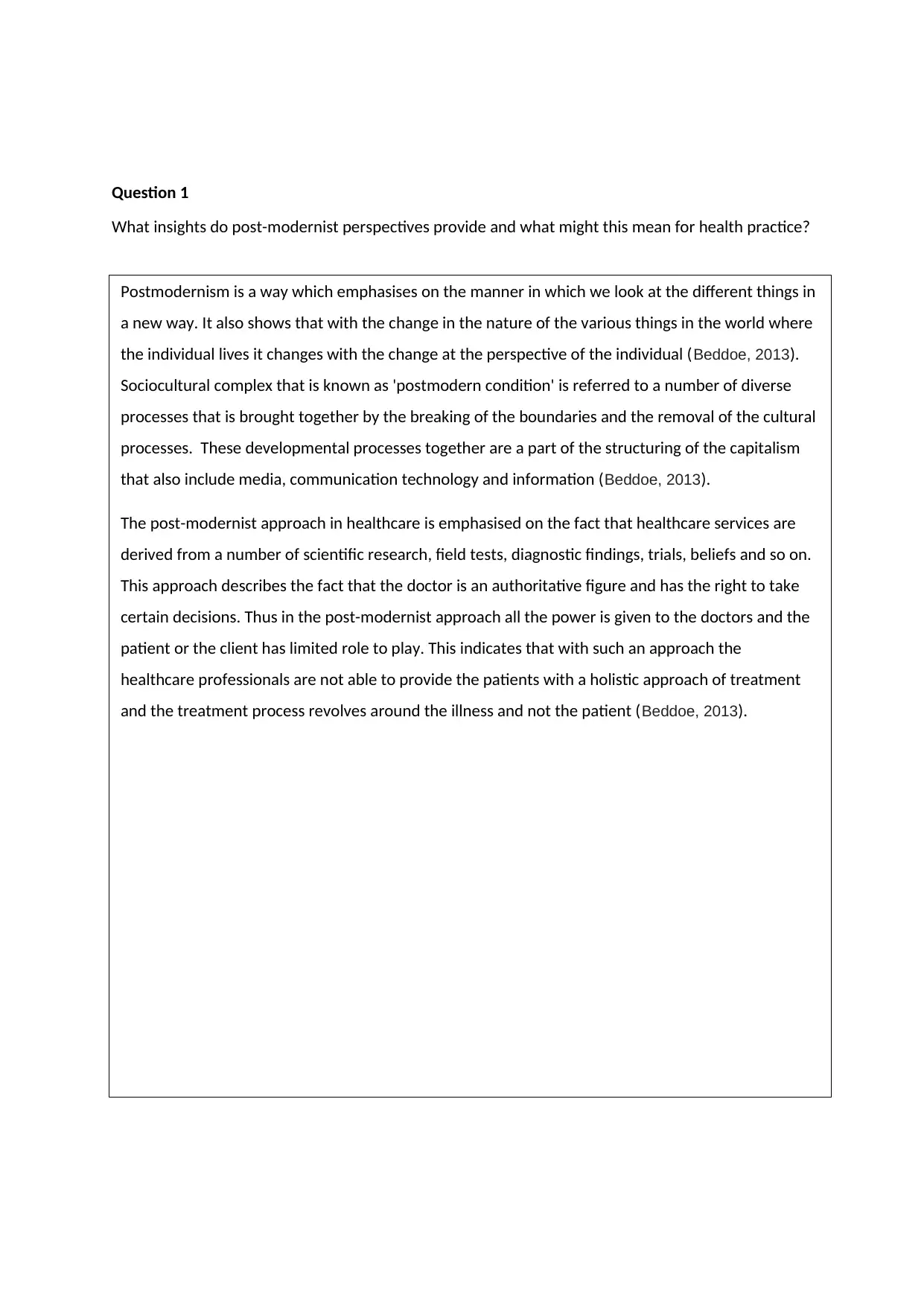
Question 1
What insights do post-modernist perspectives provide and what might this mean for health practice?
Postmodernism is a way which emphasises on the manner in which we look at the different things in
a new way. It also shows that with the change in the nature of the various things in the world where
the individual lives it changes with the change at the perspective of the individual (Beddoe, 2013).
Sociocultural complex that is known as 'postmodern condition' is referred to a number of diverse
processes that is brought together by the breaking of the boundaries and the removal of the cultural
processes. These developmental processes together are a part of the structuring of the capitalism
that also include media, communication technology and information (Beddoe, 2013).
The post-modernist approach in healthcare is emphasised on the fact that healthcare services are
derived from a number of scientific research, field tests, diagnostic findings, trials, beliefs and so on.
This approach describes the fact that the doctor is an authoritative figure and has the right to take
certain decisions. Thus in the post-modernist approach all the power is given to the doctors and the
patient or the client has limited role to play. This indicates that with such an approach the
healthcare professionals are not able to provide the patients with a holistic approach of treatment
and the treatment process revolves around the illness and not the patient (Beddoe, 2013).
What insights do post-modernist perspectives provide and what might this mean for health practice?
Postmodernism is a way which emphasises on the manner in which we look at the different things in
a new way. It also shows that with the change in the nature of the various things in the world where
the individual lives it changes with the change at the perspective of the individual (Beddoe, 2013).
Sociocultural complex that is known as 'postmodern condition' is referred to a number of diverse
processes that is brought together by the breaking of the boundaries and the removal of the cultural
processes. These developmental processes together are a part of the structuring of the capitalism
that also include media, communication technology and information (Beddoe, 2013).
The post-modernist approach in healthcare is emphasised on the fact that healthcare services are
derived from a number of scientific research, field tests, diagnostic findings, trials, beliefs and so on.
This approach describes the fact that the doctor is an authoritative figure and has the right to take
certain decisions. Thus in the post-modernist approach all the power is given to the doctors and the
patient or the client has limited role to play. This indicates that with such an approach the
healthcare professionals are not able to provide the patients with a holistic approach of treatment
and the treatment process revolves around the illness and not the patient (Beddoe, 2013).
Secure Best Marks with AI Grader
Need help grading? Try our AI Grader for instant feedback on your assignments.
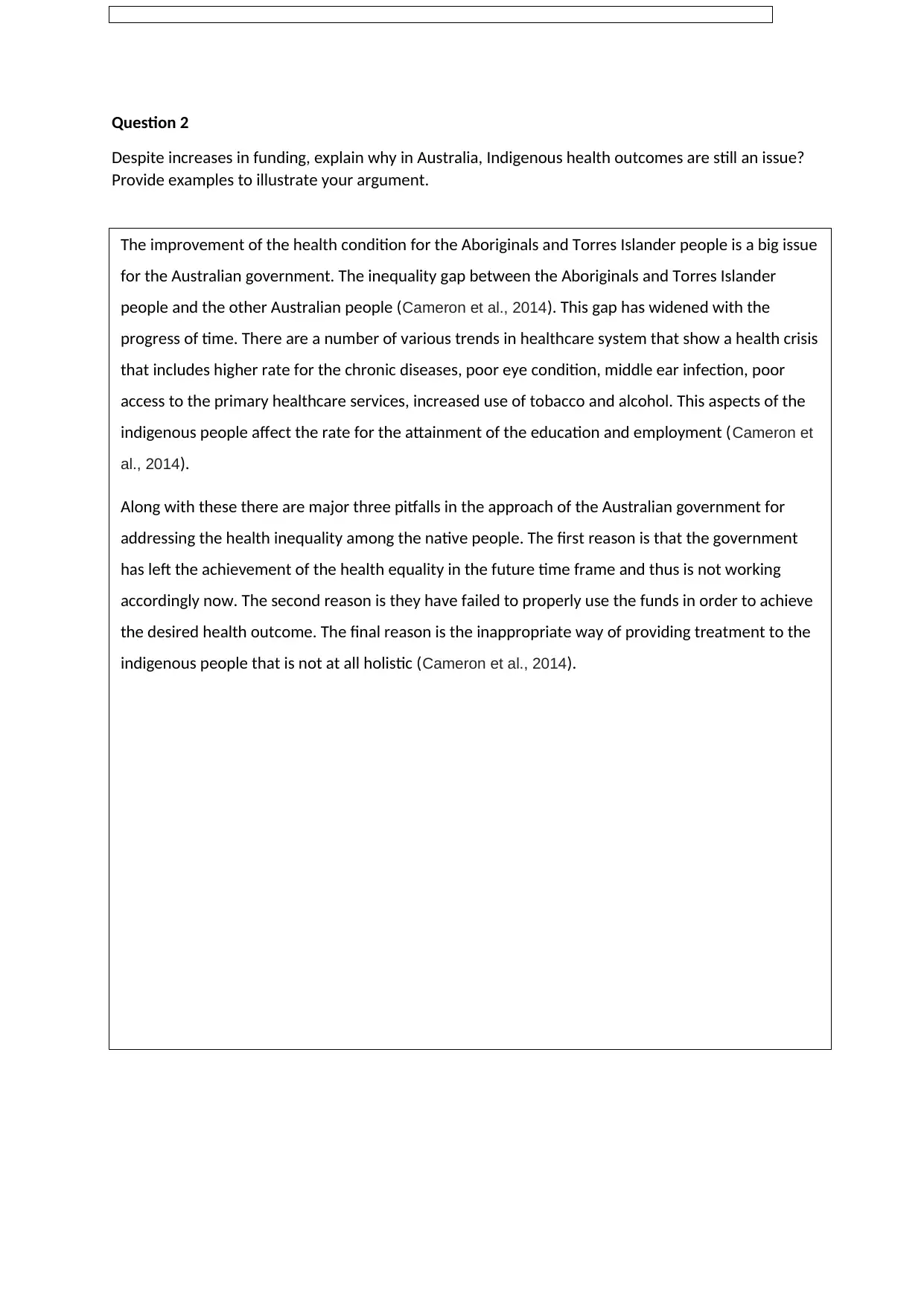
Question 2
Despite increases in funding, explain why in Australia, Indigenous health outcomes are still an issue?
Provide examples to illustrate your argument.
The improvement of the health condition for the Aboriginals and Torres Islander people is a big issue
for the Australian government. The inequality gap between the Aboriginals and Torres Islander
people and the other Australian people (Cameron et al., 2014). This gap has widened with the
progress of time. There are a number of various trends in healthcare system that show a health crisis
that includes higher rate for the chronic diseases, poor eye condition, middle ear infection, poor
access to the primary healthcare services, increased use of tobacco and alcohol. This aspects of the
indigenous people affect the rate for the attainment of the education and employment (Cameron et
al., 2014).
Along with these there are major three pitfalls in the approach of the Australian government for
addressing the health inequality among the native people. The first reason is that the government
has left the achievement of the health equality in the future time frame and thus is not working
accordingly now. The second reason is they have failed to properly use the funds in order to achieve
the desired health outcome. The final reason is the inappropriate way of providing treatment to the
indigenous people that is not at all holistic (Cameron et al., 2014).
Despite increases in funding, explain why in Australia, Indigenous health outcomes are still an issue?
Provide examples to illustrate your argument.
The improvement of the health condition for the Aboriginals and Torres Islander people is a big issue
for the Australian government. The inequality gap between the Aboriginals and Torres Islander
people and the other Australian people (Cameron et al., 2014). This gap has widened with the
progress of time. There are a number of various trends in healthcare system that show a health crisis
that includes higher rate for the chronic diseases, poor eye condition, middle ear infection, poor
access to the primary healthcare services, increased use of tobacco and alcohol. This aspects of the
indigenous people affect the rate for the attainment of the education and employment (Cameron et
al., 2014).
Along with these there are major three pitfalls in the approach of the Australian government for
addressing the health inequality among the native people. The first reason is that the government
has left the achievement of the health equality in the future time frame and thus is not working
accordingly now. The second reason is they have failed to properly use the funds in order to achieve
the desired health outcome. The final reason is the inappropriate way of providing treatment to the
indigenous people that is not at all holistic (Cameron et al., 2014).
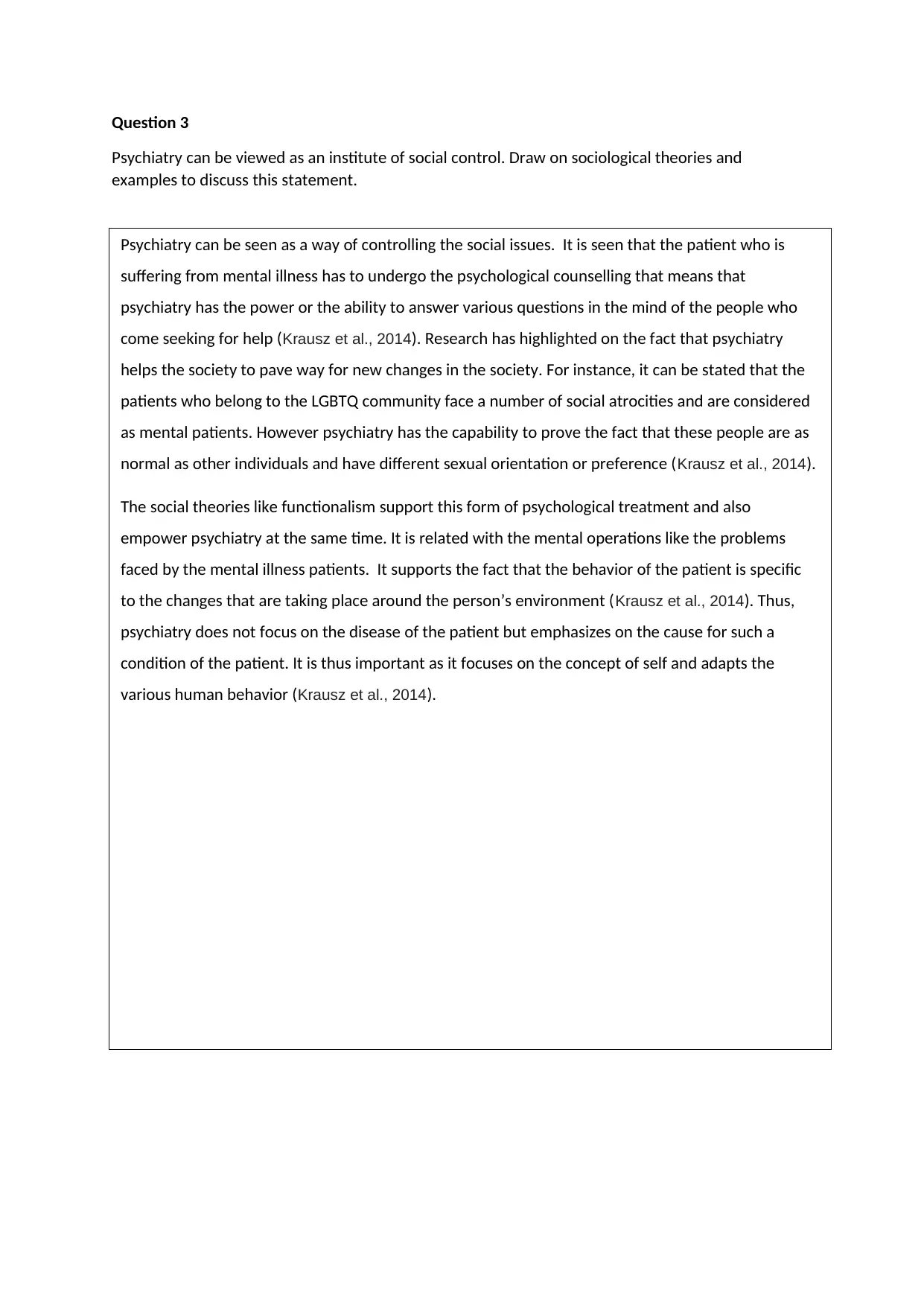
Question 3
Psychiatry can be viewed as an institute of social control. Draw on sociological theories and
examples to discuss this statement.
Psychiatry can be seen as a way of controlling the social issues. It is seen that the patient who is
suffering from mental illness has to undergo the psychological counselling that means that
psychiatry has the power or the ability to answer various questions in the mind of the people who
come seeking for help (Krausz et al., 2014). Research has highlighted on the fact that psychiatry
helps the society to pave way for new changes in the society. For instance, it can be stated that the
patients who belong to the LGBTQ community face a number of social atrocities and are considered
as mental patients. However psychiatry has the capability to prove the fact that these people are as
normal as other individuals and have different sexual orientation or preference (Krausz et al., 2014).
The social theories like functionalism support this form of psychological treatment and also
empower psychiatry at the same time. It is related with the mental operations like the problems
faced by the mental illness patients. It supports the fact that the behavior of the patient is specific
to the changes that are taking place around the person’s environment (Krausz et al., 2014). Thus,
psychiatry does not focus on the disease of the patient but emphasizes on the cause for such a
condition of the patient. It is thus important as it focuses on the concept of self and adapts the
various human behavior (Krausz et al., 2014).
Psychiatry can be viewed as an institute of social control. Draw on sociological theories and
examples to discuss this statement.
Psychiatry can be seen as a way of controlling the social issues. It is seen that the patient who is
suffering from mental illness has to undergo the psychological counselling that means that
psychiatry has the power or the ability to answer various questions in the mind of the people who
come seeking for help (Krausz et al., 2014). Research has highlighted on the fact that psychiatry
helps the society to pave way for new changes in the society. For instance, it can be stated that the
patients who belong to the LGBTQ community face a number of social atrocities and are considered
as mental patients. However psychiatry has the capability to prove the fact that these people are as
normal as other individuals and have different sexual orientation or preference (Krausz et al., 2014).
The social theories like functionalism support this form of psychological treatment and also
empower psychiatry at the same time. It is related with the mental operations like the problems
faced by the mental illness patients. It supports the fact that the behavior of the patient is specific
to the changes that are taking place around the person’s environment (Krausz et al., 2014). Thus,
psychiatry does not focus on the disease of the patient but emphasizes on the cause for such a
condition of the patient. It is thus important as it focuses on the concept of self and adapts the
various human behavior (Krausz et al., 2014).
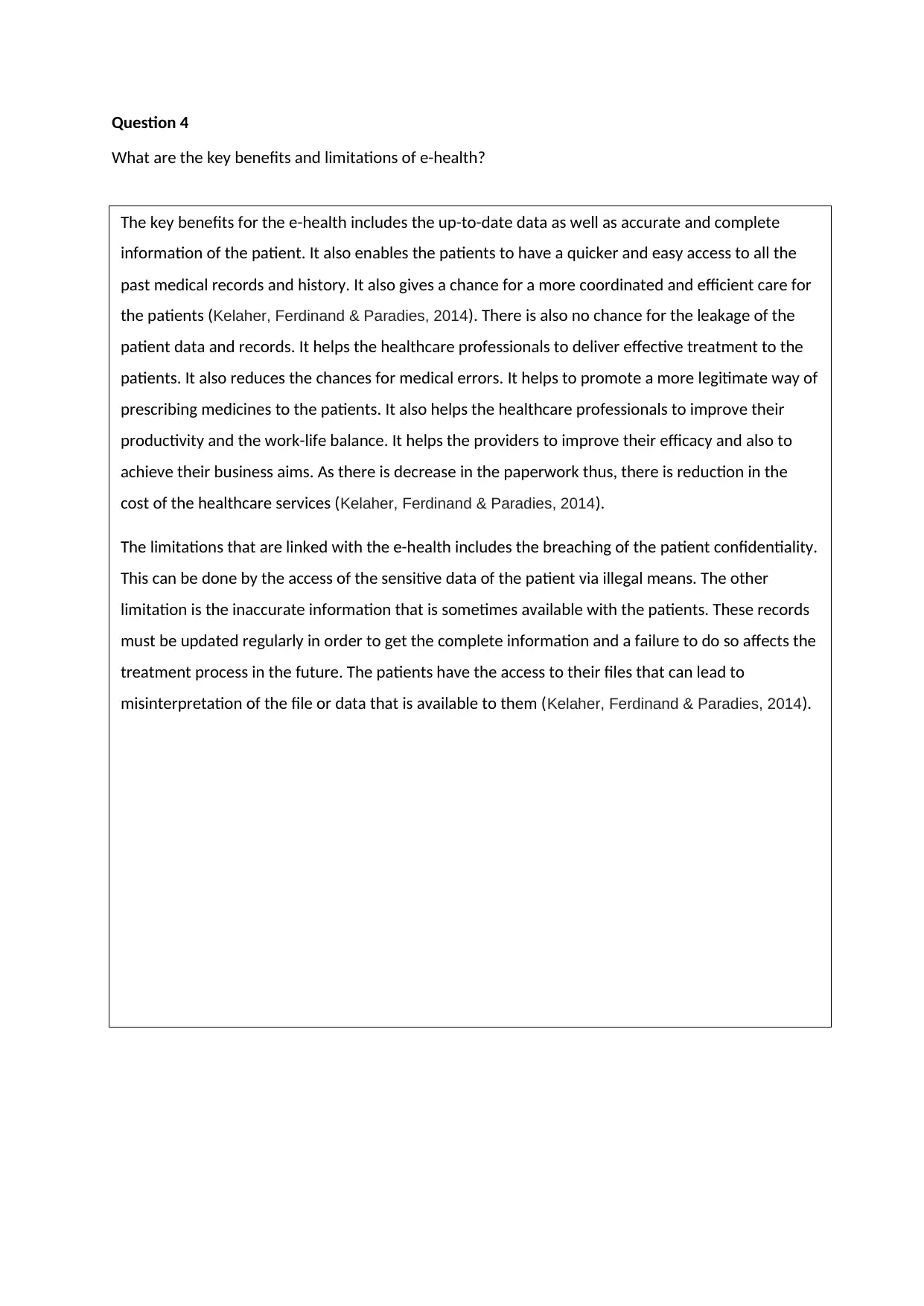
Question 4
What are the key benefits and limitations of e-health?
The key benefits for the e-health includes the up-to-date data as well as accurate and complete
information of the patient. It also enables the patients to have a quicker and easy access to all the
past medical records and history. It also gives a chance for a more coordinated and efficient care for
the patients (Kelaher, Ferdinand & Paradies, 2014). There is also no chance for the leakage of the
patient data and records. It helps the healthcare professionals to deliver effective treatment to the
patients. It also reduces the chances for medical errors. It helps to promote a more legitimate way of
prescribing medicines to the patients. It also helps the healthcare professionals to improve their
productivity and the work-life balance. It helps the providers to improve their efficacy and also to
achieve their business aims. As there is decrease in the paperwork thus, there is reduction in the
cost of the healthcare services (Kelaher, Ferdinand & Paradies, 2014).
The limitations that are linked with the e-health includes the breaching of the patient confidentiality.
This can be done by the access of the sensitive data of the patient via illegal means. The other
limitation is the inaccurate information that is sometimes available with the patients. These records
must be updated regularly in order to get the complete information and a failure to do so affects the
treatment process in the future. The patients have the access to their files that can lead to
misinterpretation of the file or data that is available to them (Kelaher, Ferdinand & Paradies, 2014).
What are the key benefits and limitations of e-health?
The key benefits for the e-health includes the up-to-date data as well as accurate and complete
information of the patient. It also enables the patients to have a quicker and easy access to all the
past medical records and history. It also gives a chance for a more coordinated and efficient care for
the patients (Kelaher, Ferdinand & Paradies, 2014). There is also no chance for the leakage of the
patient data and records. It helps the healthcare professionals to deliver effective treatment to the
patients. It also reduces the chances for medical errors. It helps to promote a more legitimate way of
prescribing medicines to the patients. It also helps the healthcare professionals to improve their
productivity and the work-life balance. It helps the providers to improve their efficacy and also to
achieve their business aims. As there is decrease in the paperwork thus, there is reduction in the
cost of the healthcare services (Kelaher, Ferdinand & Paradies, 2014).
The limitations that are linked with the e-health includes the breaching of the patient confidentiality.
This can be done by the access of the sensitive data of the patient via illegal means. The other
limitation is the inaccurate information that is sometimes available with the patients. These records
must be updated regularly in order to get the complete information and a failure to do so affects the
treatment process in the future. The patients have the access to their files that can lead to
misinterpretation of the file or data that is available to them (Kelaher, Ferdinand & Paradies, 2014).
Secure Best Marks with AI Grader
Need help grading? Try our AI Grader for instant feedback on your assignments.
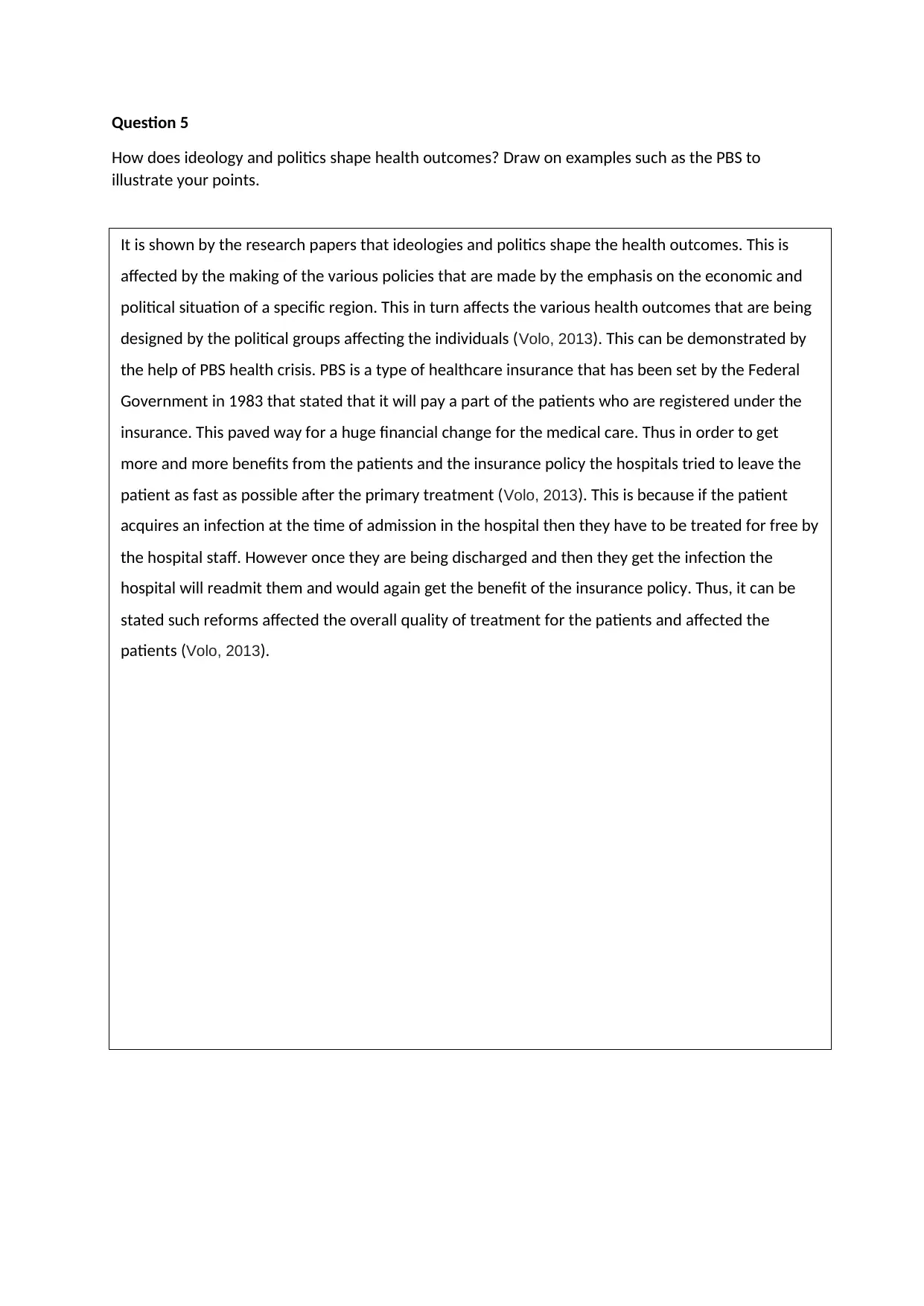
Question 5
How does ideology and politics shape health outcomes? Draw on examples such as the PBS to
illustrate your points.
It is shown by the research papers that ideologies and politics shape the health outcomes. This is
affected by the making of the various policies that are made by the emphasis on the economic and
political situation of a specific region. This in turn affects the various health outcomes that are being
designed by the political groups affecting the individuals (Volo, 2013). This can be demonstrated by
the help of PBS health crisis. PBS is a type of healthcare insurance that has been set by the Federal
Government in 1983 that stated that it will pay a part of the patients who are registered under the
insurance. This paved way for a huge financial change for the medical care. Thus in order to get
more and more benefits from the patients and the insurance policy the hospitals tried to leave the
patient as fast as possible after the primary treatment (Volo, 2013). This is because if the patient
acquires an infection at the time of admission in the hospital then they have to be treated for free by
the hospital staff. However once they are being discharged and then they get the infection the
hospital will readmit them and would again get the benefit of the insurance policy. Thus, it can be
stated such reforms affected the overall quality of treatment for the patients and affected the
patients (Volo, 2013).
How does ideology and politics shape health outcomes? Draw on examples such as the PBS to
illustrate your points.
It is shown by the research papers that ideologies and politics shape the health outcomes. This is
affected by the making of the various policies that are made by the emphasis on the economic and
political situation of a specific region. This in turn affects the various health outcomes that are being
designed by the political groups affecting the individuals (Volo, 2013). This can be demonstrated by
the help of PBS health crisis. PBS is a type of healthcare insurance that has been set by the Federal
Government in 1983 that stated that it will pay a part of the patients who are registered under the
insurance. This paved way for a huge financial change for the medical care. Thus in order to get
more and more benefits from the patients and the insurance policy the hospitals tried to leave the
patient as fast as possible after the primary treatment (Volo, 2013). This is because if the patient
acquires an infection at the time of admission in the hospital then they have to be treated for free by
the hospital staff. However once they are being discharged and then they get the infection the
hospital will readmit them and would again get the benefit of the insurance policy. Thus, it can be
stated such reforms affected the overall quality of treatment for the patients and affected the
patients (Volo, 2013).
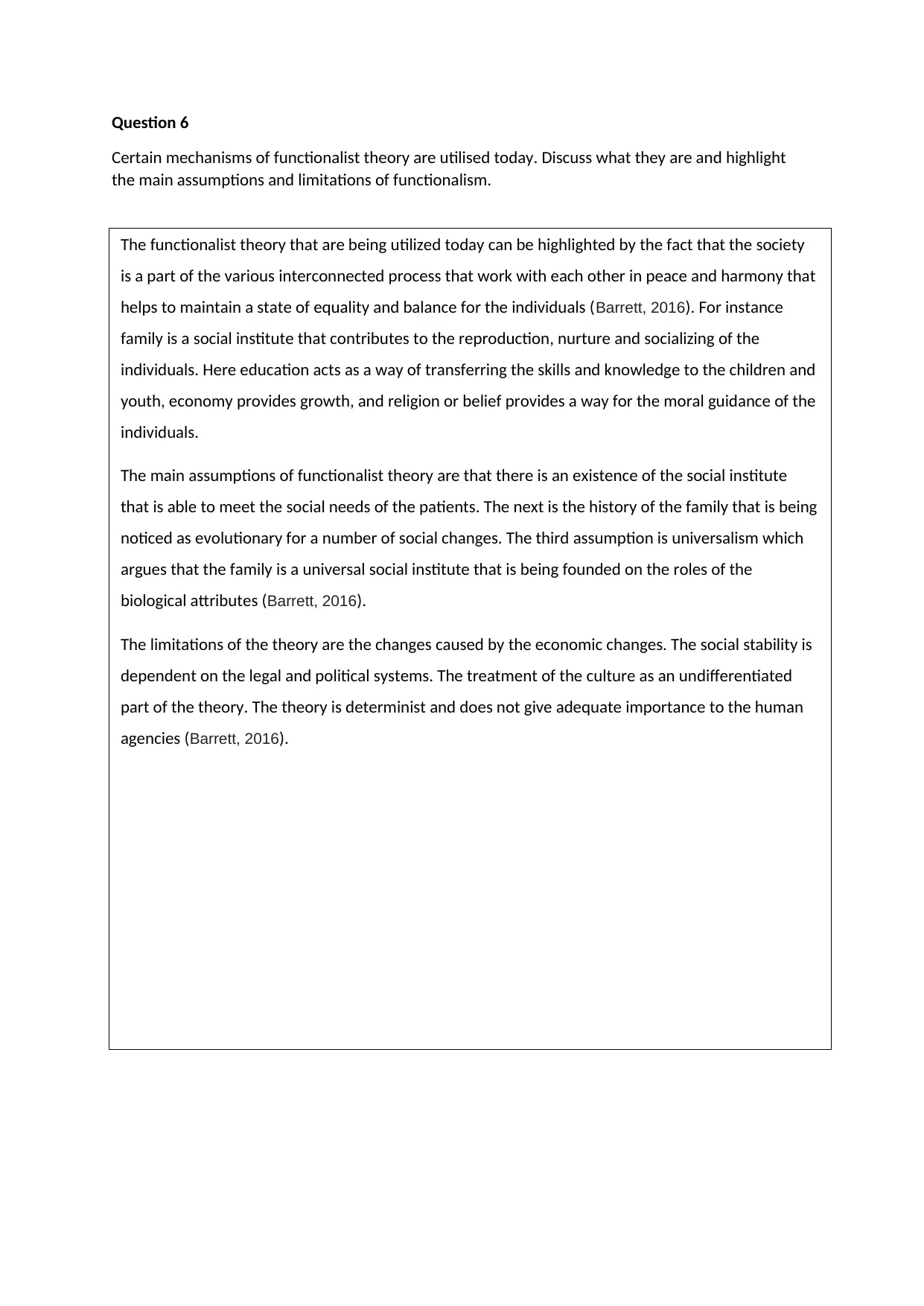
Question 6
Certain mechanisms of functionalist theory are utilised today. Discuss what they are and highlight
the main assumptions and limitations of functionalism.
The functionalist theory that are being utilized today can be highlighted by the fact that the society
is a part of the various interconnected process that work with each other in peace and harmony that
helps to maintain a state of equality and balance for the individuals (Barrett, 2016). For instance
family is a social institute that contributes to the reproduction, nurture and socializing of the
individuals. Here education acts as a way of transferring the skills and knowledge to the children and
youth, economy provides growth, and religion or belief provides a way for the moral guidance of the
individuals.
The main assumptions of functionalist theory are that there is an existence of the social institute
that is able to meet the social needs of the patients. The next is the history of the family that is being
noticed as evolutionary for a number of social changes. The third assumption is universalism which
argues that the family is a universal social institute that is being founded on the roles of the
biological attributes (Barrett, 2016).
The limitations of the theory are the changes caused by the economic changes. The social stability is
dependent on the legal and political systems. The treatment of the culture as an undifferentiated
part of the theory. The theory is determinist and does not give adequate importance to the human
agencies (Barrett, 2016).
Certain mechanisms of functionalist theory are utilised today. Discuss what they are and highlight
the main assumptions and limitations of functionalism.
The functionalist theory that are being utilized today can be highlighted by the fact that the society
is a part of the various interconnected process that work with each other in peace and harmony that
helps to maintain a state of equality and balance for the individuals (Barrett, 2016). For instance
family is a social institute that contributes to the reproduction, nurture and socializing of the
individuals. Here education acts as a way of transferring the skills and knowledge to the children and
youth, economy provides growth, and religion or belief provides a way for the moral guidance of the
individuals.
The main assumptions of functionalist theory are that there is an existence of the social institute
that is able to meet the social needs of the patients. The next is the history of the family that is being
noticed as evolutionary for a number of social changes. The third assumption is universalism which
argues that the family is a universal social institute that is being founded on the roles of the
biological attributes (Barrett, 2016).
The limitations of the theory are the changes caused by the economic changes. The social stability is
dependent on the legal and political systems. The treatment of the culture as an undifferentiated
part of the theory. The theory is determinist and does not give adequate importance to the human
agencies (Barrett, 2016).
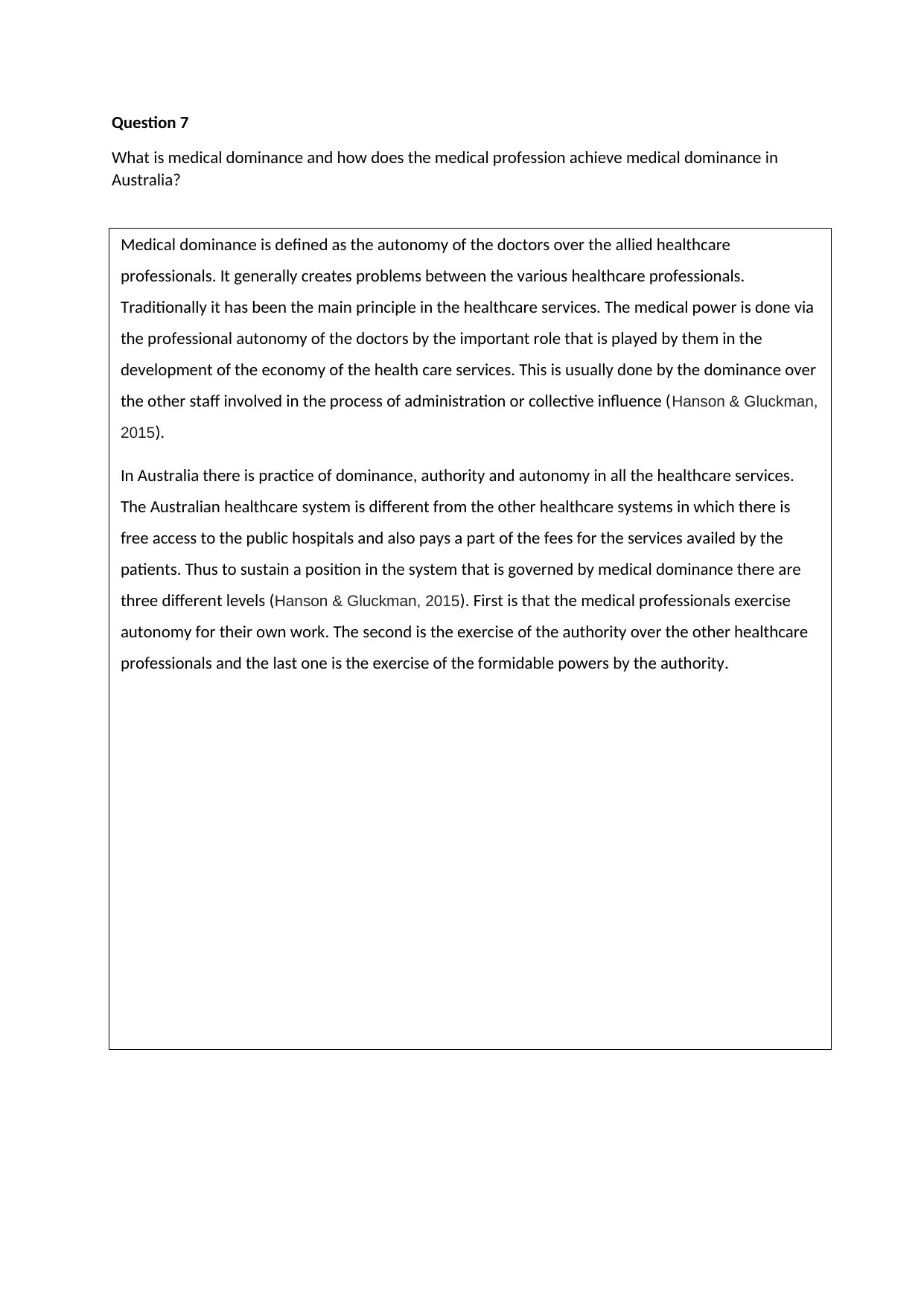
Question 7
What is medical dominance and how does the medical profession achieve medical dominance in
Australia?
Medical dominance is defined as the autonomy of the doctors over the allied healthcare
professionals. It generally creates problems between the various healthcare professionals.
Traditionally it has been the main principle in the healthcare services. The medical power is done via
the professional autonomy of the doctors by the important role that is played by them in the
development of the economy of the health care services. This is usually done by the dominance over
the other staff involved in the process of administration or collective influence (Hanson & Gluckman,
2015).
In Australia there is practice of dominance, authority and autonomy in all the healthcare services.
The Australian healthcare system is different from the other healthcare systems in which there is
free access to the public hospitals and also pays a part of the fees for the services availed by the
patients. Thus to sustain a position in the system that is governed by medical dominance there are
three different levels (Hanson & Gluckman, 2015). First is that the medical professionals exercise
autonomy for their own work. The second is the exercise of the authority over the other healthcare
professionals and the last one is the exercise of the formidable powers by the authority.
What is medical dominance and how does the medical profession achieve medical dominance in
Australia?
Medical dominance is defined as the autonomy of the doctors over the allied healthcare
professionals. It generally creates problems between the various healthcare professionals.
Traditionally it has been the main principle in the healthcare services. The medical power is done via
the professional autonomy of the doctors by the important role that is played by them in the
development of the economy of the health care services. This is usually done by the dominance over
the other staff involved in the process of administration or collective influence (Hanson & Gluckman,
2015).
In Australia there is practice of dominance, authority and autonomy in all the healthcare services.
The Australian healthcare system is different from the other healthcare systems in which there is
free access to the public hospitals and also pays a part of the fees for the services availed by the
patients. Thus to sustain a position in the system that is governed by medical dominance there are
three different levels (Hanson & Gluckman, 2015). First is that the medical professionals exercise
autonomy for their own work. The second is the exercise of the authority over the other healthcare
professionals and the last one is the exercise of the formidable powers by the authority.
Paraphrase This Document
Need a fresh take? Get an instant paraphrase of this document with our AI Paraphraser
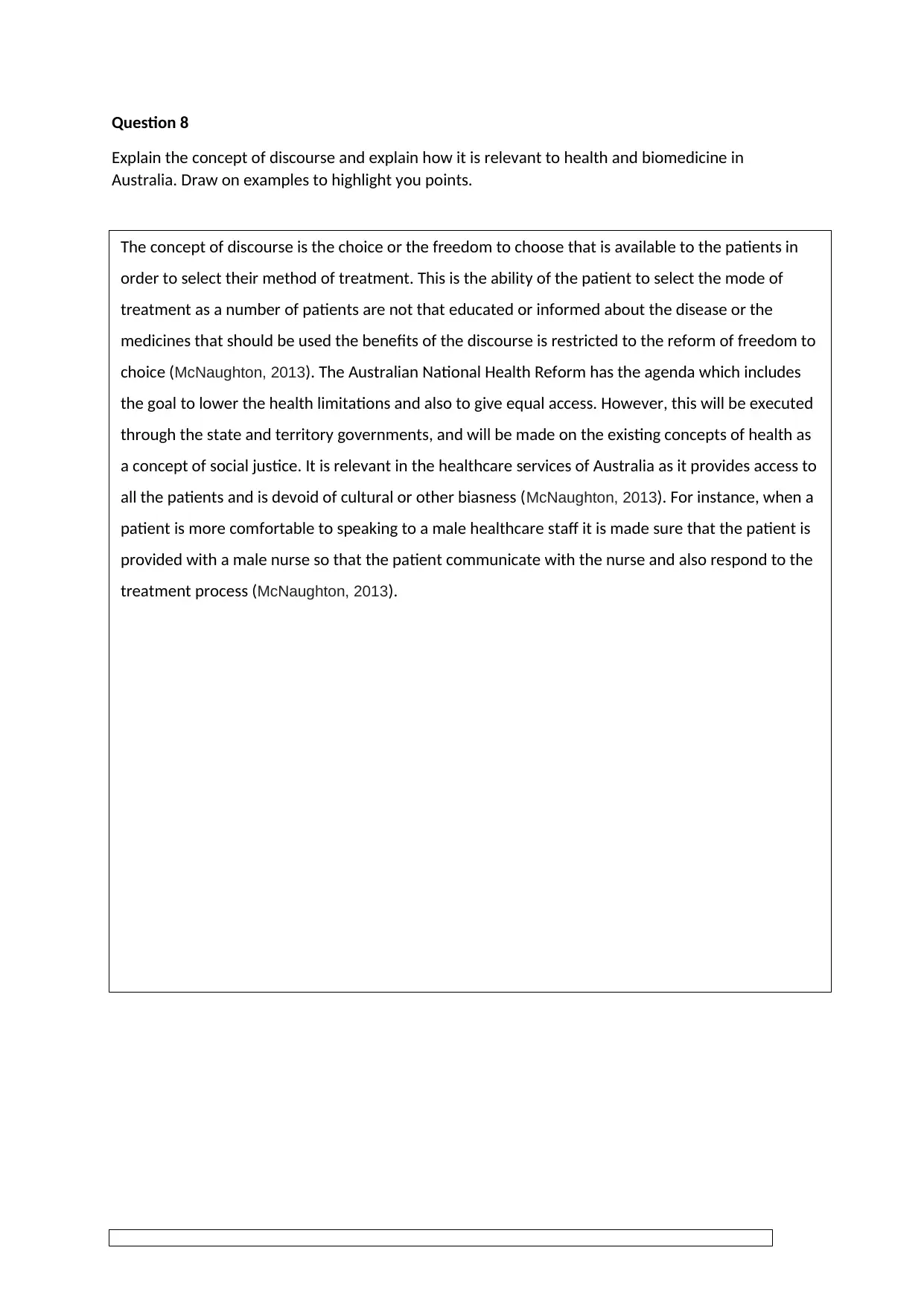
Question 8
Explain the concept of discourse and explain how it is relevant to health and biomedicine in
Australia. Draw on examples to highlight you points.
The concept of discourse is the choice or the freedom to choose that is available to the patients in
order to select their method of treatment. This is the ability of the patient to select the mode of
treatment as a number of patients are not that educated or informed about the disease or the
medicines that should be used the benefits of the discourse is restricted to the reform of freedom to
choice (McNaughton, 2013). The Australian National Health Reform has the agenda which includes
the goal to lower the health limitations and also to give equal access. However, this will be executed
through the state and territory governments, and will be made on the existing concepts of health as
a concept of social justice. It is relevant in the healthcare services of Australia as it provides access to
all the patients and is devoid of cultural or other biasness (McNaughton, 2013). For instance, when a
patient is more comfortable to speaking to a male healthcare staff it is made sure that the patient is
provided with a male nurse so that the patient communicate with the nurse and also respond to the
treatment process (McNaughton, 2013).
Explain the concept of discourse and explain how it is relevant to health and biomedicine in
Australia. Draw on examples to highlight you points.
The concept of discourse is the choice or the freedom to choose that is available to the patients in
order to select their method of treatment. This is the ability of the patient to select the mode of
treatment as a number of patients are not that educated or informed about the disease or the
medicines that should be used the benefits of the discourse is restricted to the reform of freedom to
choice (McNaughton, 2013). The Australian National Health Reform has the agenda which includes
the goal to lower the health limitations and also to give equal access. However, this will be executed
through the state and territory governments, and will be made on the existing concepts of health as
a concept of social justice. It is relevant in the healthcare services of Australia as it provides access to
all the patients and is devoid of cultural or other biasness (McNaughton, 2013). For instance, when a
patient is more comfortable to speaking to a male healthcare staff it is made sure that the patient is
provided with a male nurse so that the patient communicate with the nurse and also respond to the
treatment process (McNaughton, 2013).
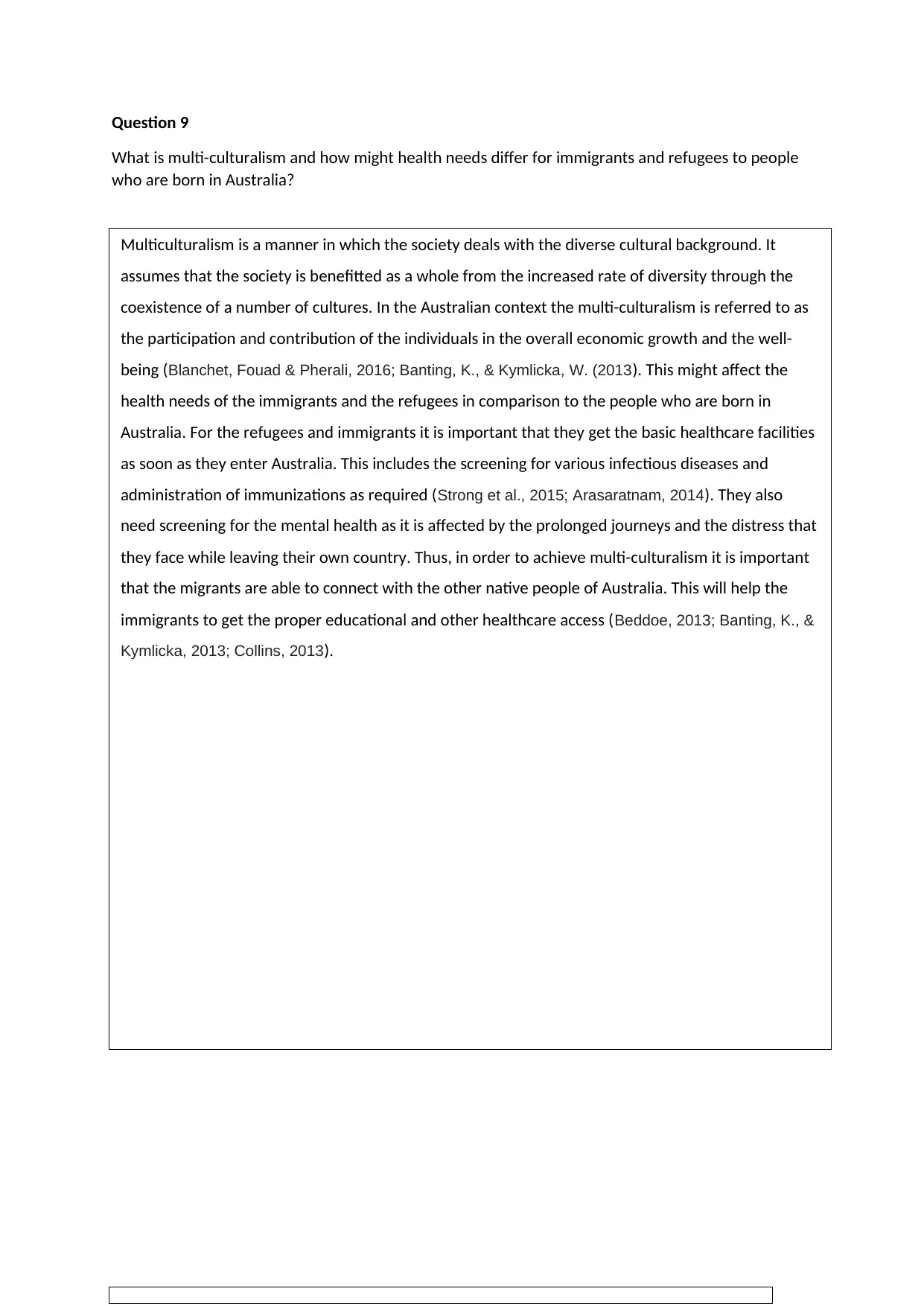
Question 9
What is multi-culturalism and how might health needs differ for immigrants and refugees to people
who are born in Australia?
Multiculturalism is a manner in which the society deals with the diverse cultural background. It
assumes that the society is benefitted as a whole from the increased rate of diversity through the
coexistence of a number of cultures. In the Australian context the multi-culturalism is referred to as
the participation and contribution of the individuals in the overall economic growth and the well-
being (Blanchet, Fouad & Pherali, 2016; Banting, K., & Kymlicka, W. (2013). This might affect the
health needs of the immigrants and the refugees in comparison to the people who are born in
Australia. For the refugees and immigrants it is important that they get the basic healthcare facilities
as soon as they enter Australia. This includes the screening for various infectious diseases and
administration of immunizations as required (Strong et al., 2015; Arasaratnam, 2014). They also
need screening for the mental health as it is affected by the prolonged journeys and the distress that
they face while leaving their own country. Thus, in order to achieve multi-culturalism it is important
that the migrants are able to connect with the other native people of Australia. This will help the
immigrants to get the proper educational and other healthcare access (Beddoe, 2013; Banting, K., &
Kymlicka, 2013; Collins, 2013).
What is multi-culturalism and how might health needs differ for immigrants and refugees to people
who are born in Australia?
Multiculturalism is a manner in which the society deals with the diverse cultural background. It
assumes that the society is benefitted as a whole from the increased rate of diversity through the
coexistence of a number of cultures. In the Australian context the multi-culturalism is referred to as
the participation and contribution of the individuals in the overall economic growth and the well-
being (Blanchet, Fouad & Pherali, 2016; Banting, K., & Kymlicka, W. (2013). This might affect the
health needs of the immigrants and the refugees in comparison to the people who are born in
Australia. For the refugees and immigrants it is important that they get the basic healthcare facilities
as soon as they enter Australia. This includes the screening for various infectious diseases and
administration of immunizations as required (Strong et al., 2015; Arasaratnam, 2014). They also
need screening for the mental health as it is affected by the prolonged journeys and the distress that
they face while leaving their own country. Thus, in order to achieve multi-culturalism it is important
that the migrants are able to connect with the other native people of Australia. This will help the
immigrants to get the proper educational and other healthcare access (Beddoe, 2013; Banting, K., &
Kymlicka, 2013; Collins, 2013).
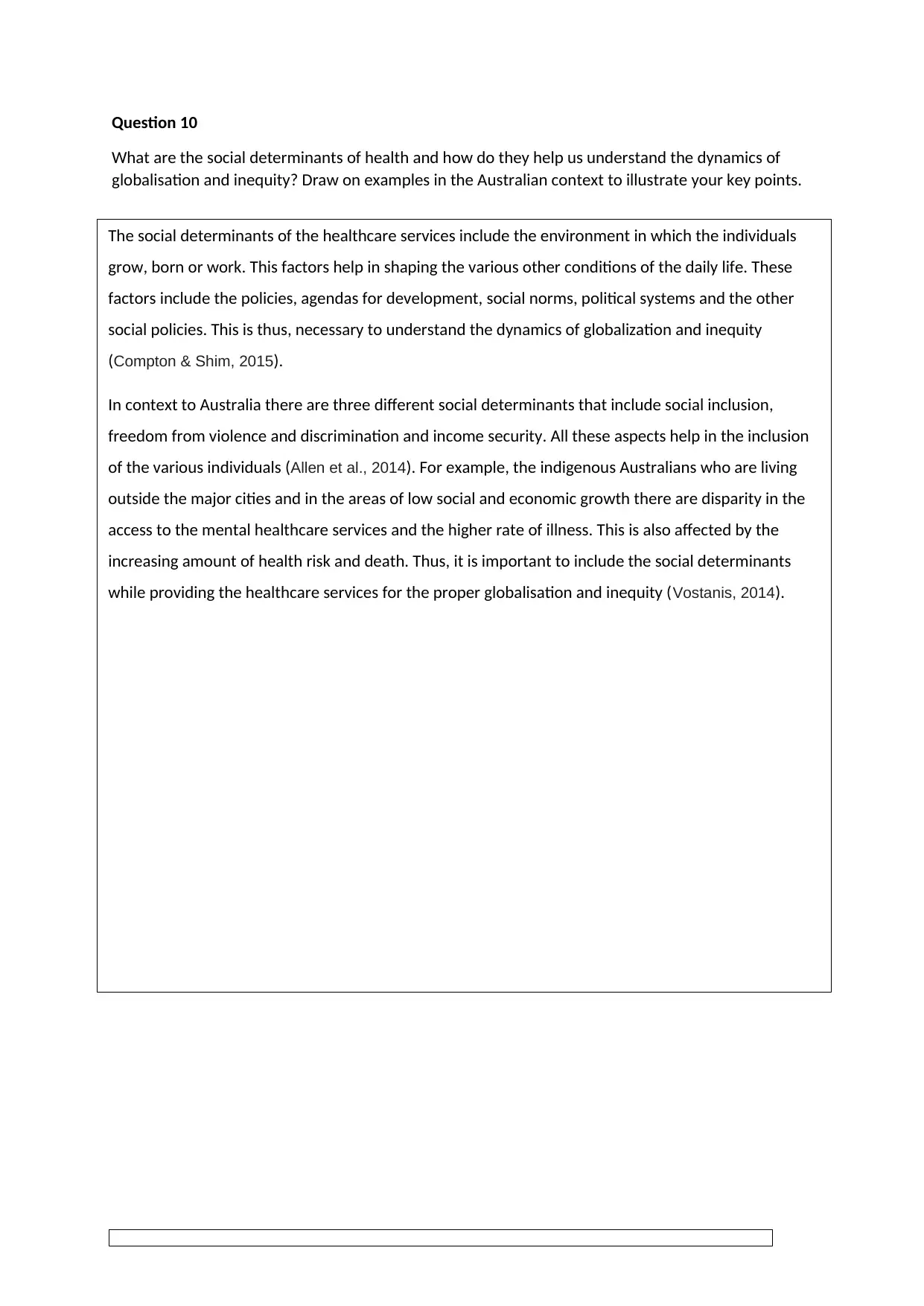
Question 10
What are the social determinants of health and how do they help us understand the dynamics of
globalisation and inequity? Draw on examples in the Australian context to illustrate your key points.
The social determinants of the healthcare services include the environment in which the individuals
grow, born or work. This factors help in shaping the various other conditions of the daily life. These
factors include the policies, agendas for development, social norms, political systems and the other
social policies. This is thus, necessary to understand the dynamics of globalization and inequity
(Compton & Shim, 2015).
In context to Australia there are three different social determinants that include social inclusion,
freedom from violence and discrimination and income security. All these aspects help in the inclusion
of the various individuals (Allen et al., 2014). For example, the indigenous Australians who are living
outside the major cities and in the areas of low social and economic growth there are disparity in the
access to the mental healthcare services and the higher rate of illness. This is also affected by the
increasing amount of health risk and death. Thus, it is important to include the social determinants
while providing the healthcare services for the proper globalisation and inequity (Vostanis, 2014).
What are the social determinants of health and how do they help us understand the dynamics of
globalisation and inequity? Draw on examples in the Australian context to illustrate your key points.
The social determinants of the healthcare services include the environment in which the individuals
grow, born or work. This factors help in shaping the various other conditions of the daily life. These
factors include the policies, agendas for development, social norms, political systems and the other
social policies. This is thus, necessary to understand the dynamics of globalization and inequity
(Compton & Shim, 2015).
In context to Australia there are three different social determinants that include social inclusion,
freedom from violence and discrimination and income security. All these aspects help in the inclusion
of the various individuals (Allen et al., 2014). For example, the indigenous Australians who are living
outside the major cities and in the areas of low social and economic growth there are disparity in the
access to the mental healthcare services and the higher rate of illness. This is also affected by the
increasing amount of health risk and death. Thus, it is important to include the social determinants
while providing the healthcare services for the proper globalisation and inequity (Vostanis, 2014).
Secure Best Marks with AI Grader
Need help grading? Try our AI Grader for instant feedback on your assignments.
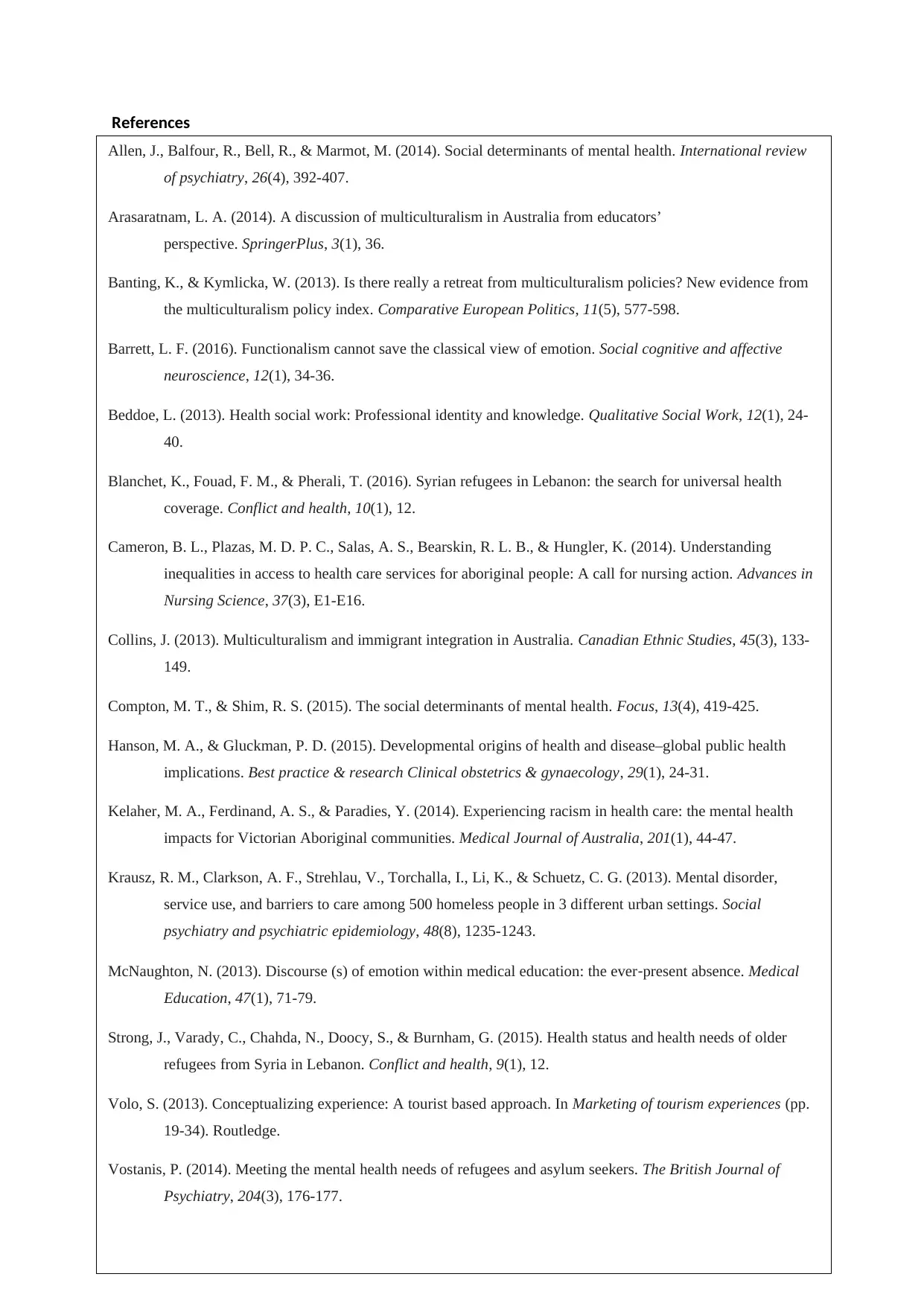
References
Allen, J., Balfour, R., Bell, R., & Marmot, M. (2014). Social determinants of mental health. International review
of psychiatry, 26(4), 392-407.
Arasaratnam, L. A. (2014). A discussion of multiculturalism in Australia from educators’
perspective. SpringerPlus, 3(1), 36.
Banting, K., & Kymlicka, W. (2013). Is there really a retreat from multiculturalism policies? New evidence from
the multiculturalism policy index. Comparative European Politics, 11(5), 577-598.
Barrett, L. F. (2016). Functionalism cannot save the classical view of emotion. Social cognitive and affective
neuroscience, 12(1), 34-36.
Beddoe, L. (2013). Health social work: Professional identity and knowledge. Qualitative Social Work, 12(1), 24-
40.
Blanchet, K., Fouad, F. M., & Pherali, T. (2016). Syrian refugees in Lebanon: the search for universal health
coverage. Conflict and health, 10(1), 12.
Cameron, B. L., Plazas, M. D. P. C., Salas, A. S., Bearskin, R. L. B., & Hungler, K. (2014). Understanding
inequalities in access to health care services for aboriginal people: A call for nursing action. Advances in
Nursing Science, 37(3), E1-E16.
Collins, J. (2013). Multiculturalism and immigrant integration in Australia. Canadian Ethnic Studies, 45(3), 133-
149.
Compton, M. T., & Shim, R. S. (2015). The social determinants of mental health. Focus, 13(4), 419-425.
Hanson, M. A., & Gluckman, P. D. (2015). Developmental origins of health and disease–global public health
implications. Best practice & research Clinical obstetrics & gynaecology, 29(1), 24-31.
Kelaher, M. A., Ferdinand, A. S., & Paradies, Y. (2014). Experiencing racism in health care: the mental health
impacts for Victorian Aboriginal communities. Medical Journal of Australia, 201(1), 44-47.
Krausz, R. M., Clarkson, A. F., Strehlau, V., Torchalla, I., Li, K., & Schuetz, C. G. (2013). Mental disorder,
service use, and barriers to care among 500 homeless people in 3 different urban settings. Social
psychiatry and psychiatric epidemiology, 48(8), 1235-1243.
McNaughton, N. (2013). Discourse (s) of emotion within medical education: the ever‐present absence. Medical
Education, 47(1), 71-79.
Strong, J., Varady, C., Chahda, N., Doocy, S., & Burnham, G. (2015). Health status and health needs of older
refugees from Syria in Lebanon. Conflict and health, 9(1), 12.
Volo, S. (2013). Conceptualizing experience: A tourist based approach. In Marketing of tourism experiences (pp.
19-34). Routledge.
Vostanis, P. (2014). Meeting the mental health needs of refugees and asylum seekers. The British Journal of
Psychiatry, 204(3), 176-177.
Allen, J., Balfour, R., Bell, R., & Marmot, M. (2014). Social determinants of mental health. International review
of psychiatry, 26(4), 392-407.
Arasaratnam, L. A. (2014). A discussion of multiculturalism in Australia from educators’
perspective. SpringerPlus, 3(1), 36.
Banting, K., & Kymlicka, W. (2013). Is there really a retreat from multiculturalism policies? New evidence from
the multiculturalism policy index. Comparative European Politics, 11(5), 577-598.
Barrett, L. F. (2016). Functionalism cannot save the classical view of emotion. Social cognitive and affective
neuroscience, 12(1), 34-36.
Beddoe, L. (2013). Health social work: Professional identity and knowledge. Qualitative Social Work, 12(1), 24-
40.
Blanchet, K., Fouad, F. M., & Pherali, T. (2016). Syrian refugees in Lebanon: the search for universal health
coverage. Conflict and health, 10(1), 12.
Cameron, B. L., Plazas, M. D. P. C., Salas, A. S., Bearskin, R. L. B., & Hungler, K. (2014). Understanding
inequalities in access to health care services for aboriginal people: A call for nursing action. Advances in
Nursing Science, 37(3), E1-E16.
Collins, J. (2013). Multiculturalism and immigrant integration in Australia. Canadian Ethnic Studies, 45(3), 133-
149.
Compton, M. T., & Shim, R. S. (2015). The social determinants of mental health. Focus, 13(4), 419-425.
Hanson, M. A., & Gluckman, P. D. (2015). Developmental origins of health and disease–global public health
implications. Best practice & research Clinical obstetrics & gynaecology, 29(1), 24-31.
Kelaher, M. A., Ferdinand, A. S., & Paradies, Y. (2014). Experiencing racism in health care: the mental health
impacts for Victorian Aboriginal communities. Medical Journal of Australia, 201(1), 44-47.
Krausz, R. M., Clarkson, A. F., Strehlau, V., Torchalla, I., Li, K., & Schuetz, C. G. (2013). Mental disorder,
service use, and barriers to care among 500 homeless people in 3 different urban settings. Social
psychiatry and psychiatric epidemiology, 48(8), 1235-1243.
McNaughton, N. (2013). Discourse (s) of emotion within medical education: the ever‐present absence. Medical
Education, 47(1), 71-79.
Strong, J., Varady, C., Chahda, N., Doocy, S., & Burnham, G. (2015). Health status and health needs of older
refugees from Syria in Lebanon. Conflict and health, 9(1), 12.
Volo, S. (2013). Conceptualizing experience: A tourist based approach. In Marketing of tourism experiences (pp.
19-34). Routledge.
Vostanis, P. (2014). Meeting the mental health needs of refugees and asylum seekers. The British Journal of
Psychiatry, 204(3), 176-177.
1 out of 11
Related Documents
Your All-in-One AI-Powered Toolkit for Academic Success.
+13062052269
info@desklib.com
Available 24*7 on WhatsApp / Email
![[object Object]](/_next/static/media/star-bottom.7253800d.svg)
Unlock your academic potential
© 2024 | Zucol Services PVT LTD | All rights reserved.
